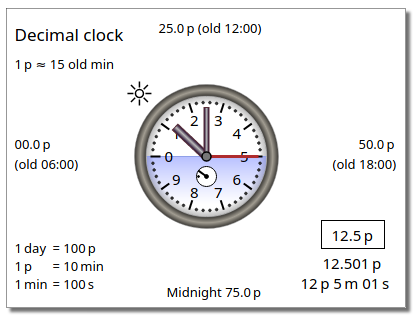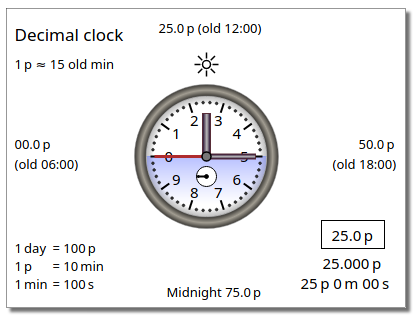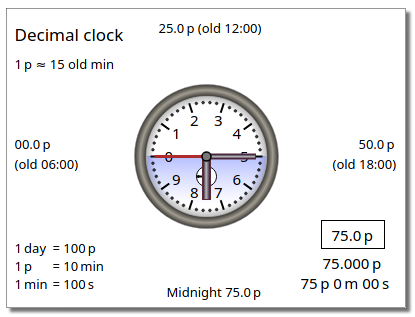Decimal clock
A short overview
This is a modified version of the decimal clock, where 1 day has 100 parts. Thus, 1 part is 1% of a day. But if we write 1%, we have always to write 1% of something! Temporarily I do not use any unit name for this decimal time unit. I am using only the symbol "p" for 1% of a day. But, I think it would be nice to call it "pan" (Do you remember Peter Pan?).
If your browser does not support inline SVG, please see the screenshot of this decimal clock.

The day starts in the morning
at 0 p (06:00 o'clock in old time units).
Thus, in the daylight we get the smaller decimal
time numbers! We have already an experience by the daylight saving
time (summer time). But this is a new clock, and it is easier to accept
the new start point 0 p of this decimal clock.
The time format is pp.m or pp.mss
(where m represents a decimal minute, and s represents a decimal second).
This clock is very simple to read:
- Tens digit (0 – 9):
the short hand is at a number or after a number.
pp.mss
- Ones digit (0 – 9):
the long hand is at a number or after a number.
pp.mss
- Minutes (0 – 9):
the red hand is at a number or after a number.
pp.mss
- Tens of seconds (0 – 9):
The red hand is at a point or at a space between the points.
pp.mss.
- Ones of seconds (0 – 9):
The small clock shows the seconds.
pp.mss.
It is easy for everybody to read the minutes of this clock.
1 p = 10 min (10 decimal minutes)
It is also very easy to give an approximate time only by "p" value (without the minutes) by a rounding of a decimal number!
The position of the short clock hand (for the tens digit of p)
can be changed after every decimal minute.
But it is better to changed it after every
10 decimal minutes (at every whole unit p). Thus, you can see easy and
directly when the short hand is before a number tick, at a number tick
or after it. This is more convenient for the most people.
If your clock shows the real local time of your geographical position
(Sun has the highest position at 25 p o'clock),
and if there are 0 or only a few minutes after a p-value,
you can use this clock also as a compass at every p-value
(from the morning to the evening of a sunny day).
The seconds are in this case not important.
If you direct the short clock hand (the tens digit hand) to the Sun,
you can find the east direction at number 0 and the west direction at
the number 5. Use the shadow of a stick to get the direction of the Sun.
Decimal time units
Time is expressed in hours, minutes and seconds.
1 day = 24 old hours
1 old hour = 60 old minutes
1 old minute = 60 old seconds
The old clock has the same position of the clock hands for the times
given by 00:00 (midnight) and 12:00 (noon).
I use the 24-hour time notation for the old time units.
hh:mm
hh:mm:ss
The French tried the decimal clock on 1793 during the French Revolution.
See the values of this decimal clock:
1 day = 10 h
1 h = 100 min
1 min = 100 s
The decimal time units above had not any success.
But the decimal time units are still a big idea!
Maybe the so-called "decimal hour" was a too big unit!
I have to try my decimal clock design by the values:
1 day = 100 p (100% of a day)
1 p = 10 min <---- decimal units
1 min = 100 s
This clock has the "fine-grained" units.
A day has 100 p. A quarter of the whole day is:
25 p = 25% of a day
Remember the parts of the day by the tens of the unit p.
See the short clock hand and the tens digit!

We have 30 p or 40 p in the afternoon. If you have more than 50 p, it is evening.

We have not any complications by the decimal minutes and seconds.
Every notation is simple to use.
36.599 p = 36.5'99 p = 36 p 5 min 99 s = 36.5 p
99 s
I am using the symbol ' (U+0027 APOSTROPHE, ') as a digit group separator.
If you see this clock, you can see also very easy that 36.5 p is approximately 37 p.
Do you see the tens digit 3? It is a decimal time value in the afternoon.
Always see first how many p units are there.
The minutes are only for a better accuracy.
Our problem is that we already think in old hours! If you start to think in decimal time units by 5 p steps, you can say that you have accepted the decimal clock.
5 p = 1 old hour + 12 old minutes
It is also:
1 p ≈ 15 old minutes (the approximate value)
2 p ≈ 30 old minutes (the approximate value)
See the Time calculations below.
We have our evening news on TV from 20:00 to 20:15 o'clock.
We can have our evening news also from 59 p to 60 p.
If you are an adult, do not forget that you have to
sleep approx. 30 p per night
(29 - 37 p or 7 - 9 old hours).
33 p = 33% of a day (approx. 1 day / 3).
For example, I need to sleep 30 p per night.
If I want to wake up at 00.0 p or 100 p
(06:00 o'clock in old time units),
I have to go to bed at
100 - 30 = 70 p.
You can add or subtract a few p values from the decimal time values above.
It is easier to work with the rounded values like 30 p.
Daily work hours
Let us have some accurate time interval values in old time units:
| Decimal time interval |
Work hours hh:mm:ss |
|---|---|
| 17 p = 170 min | 4.08 old h ≈ 4.00 old h (04:04:48 ≈ 4:00) |
| 25 p = 250 min | 6.00 old h (06:00:00 = 6:00) |
| 26 p = 260 min | 6.24 old h ≈ 6.25 old h (06:14:24 ≈ 6:15) |
| 27 p = 270 min | 6.48 old h ≈ 6.50 old h (06:28:48 ≈ 6:30) |
| 28 p = 280 min | 6.72 old h ≈ 6.75 old h (06:43:12 ≈ 6:45) |
| 29 p = 290 min | 6.96 old h ≈ 7.0 old h (06:57:36 ≈ 7:00) |
| 30 p = 300 min | 7.20 old h ≈ 7.25 old h (07:12:00 ≈ 7:15) |
| 31 p = 310 min | 7.44 old h ≈ 7.5 old h (07:26:24 ≈ 7:30) |
| 32 p = 320 min | 7.68 old h ≈ 7.75 old h (07:40:48 ≈ 7:45) |
| 33 p = 330 min | 7.92 old h ≈ 8.0 old h (07:55:12 ≈ 8:00) |
| Decimal time (p) | Work hours |
|---|---|
| 00:00:00 |
The time interval values are only for the calculation of your work time interval. If you want to know the clock time in old time units, you can set the decimal time by the input above, and see the clock time in hours below:
My clock has an offset of 6 old hours (0 p is in the morning 06:00:00). If you calculate the time only by the decimal units, this "offset problem" does NOT exist!
Do not try to think in old time units. See the decimal clock! Remember only your decimal time values!
If you start to work at (decimal) 4 o'clock, and you end your work at (decimal) 35 o'clock, the time interval is from 4 p to 35 p. You have worked 35 p − 4 p = 31 p. It is easier to start and end your work at the full p values (with 0 minutes). If you work usually 7 old hours per day, you can work 29 p (see the Table above). If you want, the work time can be changed by plus minus 1 p (approx. 15 old minutes) to get the right decimal time values. For example I would like to work 30 p per day. You can remember your important decimal time values.
Hourly wage
Let us have the dollar as an example currency. It can be any other currency. If you get for example 8 $/h (8 dollar per old hour), it is very easy to calculate the accurate value of your money:
1 old hour ––––> 1 h · 8 $/h = 8 $
1 old hour ––––> 8 $
It is 1 p = 0.24 old hours.
We get in old hours:
0.24 old hour ––––> 0.24 h · 8 $/h
0.24 old hour –––––> 1.92 $
–––––––––––––––––––––––––––––––––––––––––––––––––––
Thus, we get in decimal time units:
1 p ––––> 1.92 $ (the accurate value)
In this case we get 1.92 $/p. See the examples below:
4 p ––––> 4 p · 1.92 $/p = 7.68 $
2 p ––––> 2 p · 1.92 $/p = 3.84 $
1 p ––––> 1 p · 1.92 $/p = 1.92 $
Of course, you can calculate also your money per decimal minute:
1.92 $/p = 1.92 $/(10 min) = 0.192 $/min
5 min ––––> 5 min · 0.192 $/min = 0.96 $
If you know a money value per old hour, you can calculate its accurate money value per "p" or per decimal minute. Thus, it must be emphasized that 25 p (25% of a day) and 6 old hours (25% of a day) represent the same time. If you work 25% of a day, you get always the same money for your work, independent from the time units.
Time calculations
The problem are our old hours and old minutes. We have:
1 day = 24 old hours = 1440 old minutes = 86400 old seconds
But in decimal time units we get:
1 day = 100 p = 100 · 10 min = 1000 min
1 day = 1000 min = 1000 · 100 s = 100'000 s
If
1 day = 100'000 seconds and
1 day = 86'400 old seconds
it is also
1 s = 0.864 old seconds = 864 old milliseconds
–––––––––––––––––––––––––––––––––––––––––––––––––
1 min = 100 s
1 min = 100 · 0.864 old seconds = 86.4 old seconds
1 min = (60 + 26.4) old seconds
1 min = 1 old minute + 26.4 old seconds
1 min ≈ 1.5 old minutes
1 decimal minute is approximately 1.5 old minutes!
7 min = 7 · 100 s = 7 · 100 · 0.864 old seconds
7 min = 604.8 old seconds (or approx. 600 old seconds)
7 min ≈ 10 · 60 old seconds
7 min ≈ 10 old minutes
1 p = 10 min = 10 · 100 s = 10 · 100 · 0.864 old seconds
1 p = 864 old seconds
1 p = 14 old minutes + 24 old seconds
1 p ≈ 15 old minutes
1 p is approximately 15 old minutes!
Thus, we get:
1 p ≈ 0.25 old hour
2 p ≈ 0.5 old hour
4 p ≈ 1 old hour
Use the approximate values above only for a few (not many) p values.
–––––––––––––––––––––––––––––––––––––––––––––––––
See also the accurate time calculations below.
In a day we have:
100 p = 24 old hours
Thus, we get the accurate value
1 p = 0.24 old hours
If you have x · 1 p, you can calculate its accurate value in old hours by:
x · 1 p = x · 0.24 old hours
5 p = 5 · 0.24 old hours = 1.2 old hours
5 p = 1 old hour + 0.2 old hour = 1 old hour + 0.2 · 60 old minutes
5 p = 1 old hour + 12 old minutes
If you forget the old time units, the calculations from above are not needed anymore!
Unit of speed
Let us have a speed 40 km/h. It is
1 p · 40 km/h = 0.24 h · 40 km/h = 9.6 km or approx. 10 km
Thus,
40 km/h ≈ 10 km/p
If a street has a speed limit 40 km/h, it can have also a speed limit 10 km/p.
The values in km/p can be used by a speedometer.
2 km/p = 8.333 km/h
5 km/p = 20.833 km/h
10 km/p = 41.667 km/h
12 km/p = 50.0 km/h
15 km/p = 62.5 km/h
20 km/p = 83.333 km/h
24 km/p = 100.0 km/h
25 km/p = 104.167 km/h
30 km/p = 125 km/h
...
60 km/p = 250 km/h
You can see that the values in km/p are much better!
A tick in a speedometer can represent even the speed 1 km/p.
If you have a speed 1 km/p, how many meters are in a decimal minute?
Use a simple mental calculation! 1 p of my clock has 10 decimal minutes.
It is also 1 km = 1000 m and 1 p = 10 min = 10 · 100 s = 1000 s
1 km / 1 p = 1000 m / 1000 s,
1 km/p = 1 m/s, where s represents the decimal second.Thus, for example it is 24 km/p = 24 m/s in decimal units. Now you can imagine the speed given by 24 km/p (or 100 km/h). If we use the decimal second (1 s = 0.864 old seconds) and the unit p, even a car speedometer can use the decimal speed unit m/s. We must be conscious of our speed! This is more important than anything else. But for the mental calculation of the bigger distances, we can use also the unit km/p. A speed has the same magnitude in decimal m/s. If the second (given by the symbol "s") is a decimal second, the unit m/s is a decimal unit.
This is all you have to know about the decimal clock. It needs a support from everybody. Make something good for yourself and for all new generations! Accept the decimal clock! Although old habits die hard, maybe the big idea of the decimal clock will be not only a dream! However, it is worth a try!
2019-07-28, Lulzim Gjyrgjialli
